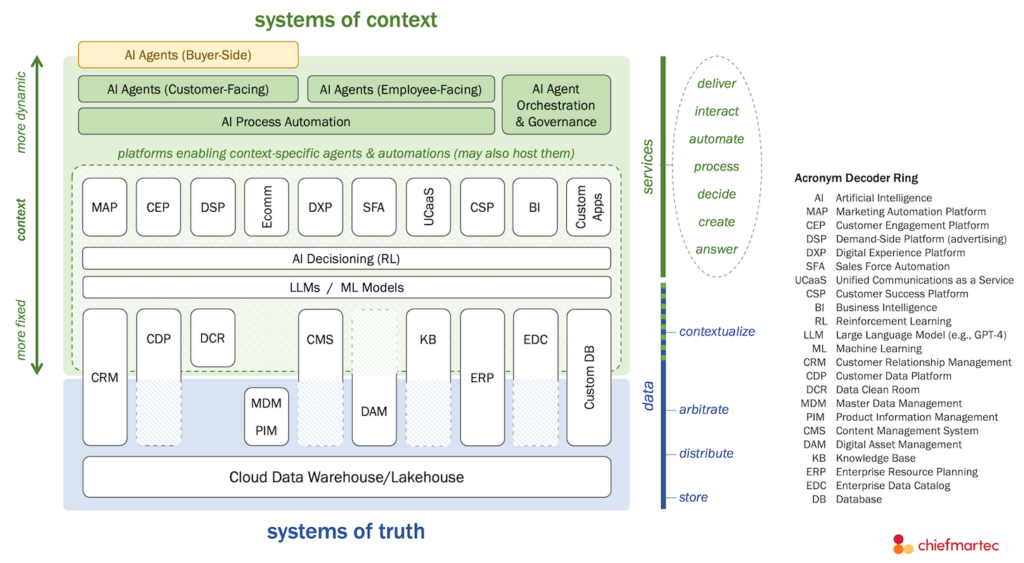The following is a guest post by Jeremy Epstein, CEO of Never Stop Marketing. Jeremy currently works with several of the leading companies in the blockchain and decentralization space including OB1 and OpenBazaar. Previously, he was VP of marketing at Sprinklr.
You’ve probably heard about Bitcoin. You may have heard about the blockchain. It’s the underlying technology that makes Bitcoin possible without any centralized authority.
Odds are, though, you haven’t given much thought to how the role of marketing is going to get up-ended because of blockchains. However, if Bitcoin proves to be the tip of the iceberg, then “decentralization” — what lies below the surface — is much bigger and more important.
To be fair, “decentralization” isn’t going to get here next week. But if you are a marketer who isn’t planning on retiring in the next year, it’s probably worth spending a bit of time to understand the potential change.
We’ve seen this movie before
In the mid 90s, marketers heard about “email” and “the web.” Then they heard about the “Internet.” Only after that, did they start to understand how dynamic and interactive marketing could be.
In the mid 2000s, it happened again. Marketers heard about Facebook and Twitter. Then, it was “social media.” Finally, they began to adapt to the implications that customers were connected and empowered in a way previously unimaginable.
Marketers who recognize that blockchains represent another seismic shift have a large opportunity in front of them. History may be repeating itself.
Why blockchains aren’t hype
As a 20-year veteran of technology marketing, I’ve seen plenty of headlines like these (actual real examples):
- Six Ways that Google Wave is Going to Change Your Business, Career, and Life
- How Vine, Twitter’s New Video Service, Will Change Your Business
- 5 Unexpected Ways Meerkat Will Crush It For Sales and Marketing People
We’re used to over-hyping things. Heck, as marketers, part of our jobs is generating excitement. So we’re naturally a bit cynical of a claim from any marketer other than ourselves.
The case for blockchains and decentralization comes down to 3 points:
- It’s already happening.
- The pace of life requires it.
- The future needs it.
In the “it’s already happening” category, you have Bitcoin. Nine years old and going strong — admittedly with some volatility — but never been hacked and recognized as a store of value.
Then, you can add in the fact that the DTCC plans to use blockchain to settle its $11 trillion in derivatives trades, Homeland Security is looking at blockchain to track goods and people across borders, and the FDA is looking at blockchain to help with population health management. And that doesn’t even touch on the numerous efforts within the Financial Services industry.
As for the “pace of life” argument, it’s simple. If you want to email, text, share a picture, file or video with anyone in the world, you can do it instantly. Yet, if you want to transfer something of actual economic value, say… money, the title to a car, apartment, or house, rights to a song or a painting, or stock, it can take days or weeks. Time is money, and these slow systems are costing us. Blockchains will solve many of these issues.
Finally, the Internet of Things requires it. The billions of devices that are coming will share information with each other and pay/get compensated for doing so at the micro-transaction level. The volume of transactions demands an “Internet-friendly” way of making payments. Blockchain-based cryptocurrencies make the most sense. Your smart watch isn’t going to make a credit card payment to a charging station for 2 cents worth of power, but a blockchain-based system can and will.
And if that isn’t enough, Marc Andreesen provides additional reasons.
What all this means for marketers
Many of the “givens” of marketing as they currently exist could come under pressure. For example:
- Individuals, not brands, will control access identity and personal information through services like uPort, MetaMask, Blockstack, or Keybase.
- Brand affinity will align to decentralized protocols that represent a set of core values. For example, the people who choose to participate in a censorship-resistant marketplace like OpenBazaar instead of eBay.
- Value will get created not by owning customer data, but by how companies help customers use, interpret, and interface with data. This is how Coinbase competes with BitGo, Jaxx, and LedgerWallet to interface with the addresses you control on the Bitcoin blockchain.
- A marketer’s claim will never be accepted as is. As Jack Trout wrote, “claims of difference without proof are really just claims.” The supply chain, for example, becomes a key part of the value proposition. Witness how Walmart plans to blockchain to track pork provenance in China.
- Assets like loyalty points and coupons may become freely tradeable and interchangeable via services like ShapeShift. Loyalty points alone won’t be enough to lock customers into a relationship.
- Attention won’t be free. Customers will use social media platforms like Steem where attention and participation are rewarded and earned. Marketers will need to engage in a meaningful way to warrant engagement. They won’t be able to buy attention. (Note: this will impact email as well.)
This is just the beginning and doesn’t even touch on things such as:
- Asset programmability which could impact budget tracking and management
- Prediction markets like Augur and Gnosis which could impact forecasting
- Crypto-tokens and how they will be the measure of value within a network
- Anonymous currencies like Zcash and Monero that customers will want to use
- The fact that companies like Microsoft and IBM are “going big” in blockchain solutions already
Much like no one predicted Spotify, Uber, Seamless, or Hulu back in the 90s, we can’t predict how this technology will evolve or impact us. However, the data points are amassing that blockchain technology is for real.
What you can do now
Companies and marketers often ask me what they can do now to begin preparing. They want to future-proof their businesses and their careers. They also want to know what leading start-ups such as OpenBazaar and Storj (disclosure: clients) are doing.
After pointing them to the free eBook, Blockchains in the Mainstream, which features 33 of the leaders in the industry offering their prognostication, I suggest the following exercise. Imagine that:
- Any asset can now be digital.
- All customer transaction data is shared among all the competitors in the industry.
- Business and legal rules could be “hard-coded” into an asset itself.
- You have to pay for customer attention at every touchpoint.
- There are no 3rd-party intermediaries.
How would you build a business, a marketing function, and a customer relationship in that environment?
Doing this now is like taking out an insurance policy against disruption or disintermediation. It’s worth the premium. As William Gibson put it: “The future has arrived — it’s just not evenly distributed yet.”
Thanks, Jeremy!
Readers: Jeremy will be speaking at the MarTech Conference in San Francisco, May 9-11, with a fantastic presentation on Marketing in a Blockchain World. Register today for the lowest “alpha” rate on tickets to guarantee your seat.





Jeremy is right, Blockchain is going to be big. I am not across the detail to anywhere near the same extent as he is and can’t even begin to sketch out how this is going to affect brands and marketing, but the reason I get the significance of Blockchain is that at its heart it is all about the shift of trust from institutions into transparent processes – and this is what the whole social digital revolution is about (see this from 2009) http://richardstacy.com/2009/06/05/andrew-keens-head-and-the-shift-from-institutions-to-processes/
It is going to do to the distribution of value what the internet did to the distribution of information.
One thing I have learned over the years is that Richard Stacy is a pretty freaking smart guy, so whatever he says is probably accurate! 😉
Read his blog. The major point of movement from trust in institutions into transparent processes as it relates to the distribution of value is totally on point.